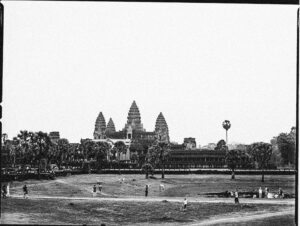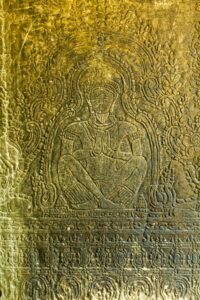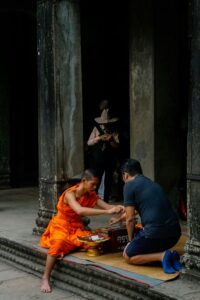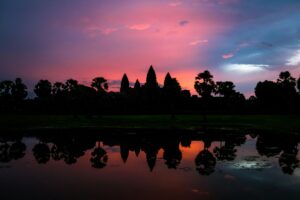Exploring Angkor Wat: The Ultimate Guide for Tourists
Angkor Wat is one of the world’s most magnificent religious monuments and a must-visit destination in Cambodia. Originally constructed as a Hindu temple in the 12th century and later transformed into a Buddhist site, Angkor Wat has captivated travelers for centuries with its grand architecture, intricate carvings, and spiritual ambiance. This guide will help you make the most of your visit to Angkor Wat by exploring its history, highlights, and essential travel tips.

A Brief History of Angkor Wat
Built in the early 12th century during the Khmer Empire’s peak, Angkor Wat was initially dedicated to the Hindu god Vishnu. The temple was commissioned by King Suryavarman II and was intended as his mausoleum. The architectural grandeur and symbolic significance of Angkor Wat reflect the ambition and devotion of the Khmer civilization. Over time, the temple shifted to a Buddhist site, a transformation that is still evident in the numerous Buddhist statues and carvings found alongside Hindu imagery.
Angkor Wat has since become a symbol of Cambodia, even appearing on the national flag. It represents the country’s deep cultural and spiritual heritage and continues to draw millions of visitors each year.
Getting to Angkor Wat
Angkor Wat is located near Siem Reap, a popular city in northwestern Cambodia. From Siem Reap, the temple complex is only about a 15-minute drive, making it easily accessible.
- By Tuk-Tuk: Hiring a tuk-tuk is a popular and convenient option. It allows you to explore the site at your own pace, and drivers often offer guided services.
- By Bicycle: For the adventurous, renting a bike is an affordable way to explore Angkor Wat and nearby temples, though keep in mind the distances and weather.
- By Private Car or Tour: Many tourists choose private tours with knowledgeable guides, especially for a more in-depth understanding of the site’s history and architecture.
Tip: Aim to arrive early in the morning to witness the sunrise over Angkor Wat—a truly mesmerizing experience.
Entrance Fees and Opening Hours
- Entrance Fee: Tickets for Angkor Wat are priced at $37 for a single-day pass, $62 for a three-day pass, and $72 for a seven-day pass. Tickets can be purchased at the Angkor Ticket Office, about 4 km from Siem Reap.
- Opening Hours: Angkor Wat is open daily from 5:00 AM to 5:30 PM, with the sunrise being a popular time for visitors. Note that some temples within the complex may have different hours.
Tip: Keep your ticket with you at all times, as there are frequent checks at various temple entrances.

Top Attractions Within Angkor Wat
Angkor Wat’s vast temple complex covers over 400 acres, and each section holds unique features. Here are the top highlights:
- The Central Tower: The heart of Angkor Wat, this iconic five-towered structure is designed to symbolize Mount Meru, the sacred mountain in Hindu mythology. The steep climb to the top rewards visitors with stunning panoramic views.
- The Bas-Reliefs: Angkor Wat is famous for its intricate bas-relief carvings, depicting scenes from Hindu mythology, including the “Churning of the Ocean of Milk.” This 50-meter-long panel on the temple’s outer gallery is one of the most detailed and well-preserved carvings in the complex.
- The Outer Moat: Surrounding Angkor Wat is a 190-meter-wide moat, symbolizing the cosmic ocean in Hindu belief. Walking around the moat and entering through the western gate gives visitors a sense of the grandeur of the temple’s original approach.
- Libraries and Reflection Pools: The two libraries and reflection pools at the front of Angkor Wat are not just architectural features but also popular spots for capturing the temple’s iconic reflection, particularly during sunrise and sunset.

Exploring the Angkor Archaeological Park
Angkor Wat is just one part of the larger Angkor Archaeological Park, which includes several other notable temples:
- Angkor Thom: The ancient walled city of Angkor Thom was the last capital of the Khmer Empire. Its main entrance, flanked by 54 gods and demons, leads to the Bayon Temple, famous for its 200 serene stone faces.
- Ta Prohm: Known as the “Tomb Raider Temple” for its appearance in the famous movie, Ta Prohm is famous for the large trees and roots that envelop its ruins, creating a mystical and photogenic atmosphere.
- Banteay Srei: Often called the “Citadel of Women,” this smaller temple is known for its red sandstone and elaborate carvings, depicting tales from Hindu epics.
- Preah Khan: Built by King Jayavarman VII, Preah Khan is a vast complex with a unique combination of Buddhist and Hindu imagery. It’s less crowded than Angkor Wat and offers an off-the-beaten-path experience.
Travel Tips for Visiting Angkor Wat
- Dress Code: Angkor Wat is a religious site, so respectful attire is required. Wear clothing that covers your shoulders and knees, as revealing outfits may result in restricted access.
- Bring Sun Protection: The Cambodian sun can be intense, especially around midday. Bring sunscreen, a hat, and plenty of water.
- Respect the Site: Avoid climbing on fragile structures, and remember that Angkor Wat is a place of worship for Buddhists and locals. Refrain from touching statues or carvings, and remain quiet in prayer areas.
Tip: Consider hiring a local guide who can share insights into Angkor Wat’s history, myths, and architecture, greatly enhancing your visit.

Capturing the Sunrise and Sunset
One of the most magical experiences at Angkor Wat is watching the sunrise. As dawn breaks, the temple’s reflection in the nearby pools creates a breathtaking view, with the sky painted in hues of orange and pink.
- Best Sunrise Spot: For the best view, head to the reflection pools near the entrance before 5:00 AM to secure a spot.
- Sunset Spots: While Angkor Wat itself is best for sunrise, other nearby temples like Phnom Bakheng and Pre Rup offer beautiful sunset views over the surrounding jungle.
Tip: Crowds can be significant during sunrise and sunset, so arrive early to enjoy a quieter moment.

Respecting Culture and Conservation Efforts
Angkor Wat is not only a historical site but also a spiritual place for Cambodian people. Here are a few etiquette tips to show respect:
- Don’t Touch the Carvings: The intricate carvings of Angkor Wat are centuries old and fragile, so it’s essential not to touch or lean on them.
- Avoid Flash Photography: Inside temple structures, avoid using flash, as it can damage the delicate stonework.
- Keep Noise to a Minimum: Angkor Wat remains an active religious site, with locals coming to pray. Maintain a quiet demeanor, especially around monks and worship areas.
By following these guidelines, tourists can help preserve Angkor Wat for future generations while honoring its cultural and spiritual importance.
Final Thoughts: Embracing the Magic of Angkor Wat
A visit to Angkor Wat is an awe-inspiring experience that allows travelers to step back in time and explore the grandeur of the Khmer Empire. From sunrise views to intricate carvings, each moment at Angkor Wat offers a glimpse into Cambodia’s rich history and spiritual heritage. By following these tips, you’ll be able to fully appreciate the beauty, significance, and serenity of this UNESCO World Heritage Site. Angkor Wat is more than just a monument—it’s a timeless marvel that leaves an unforgettable impression on all who visit.
